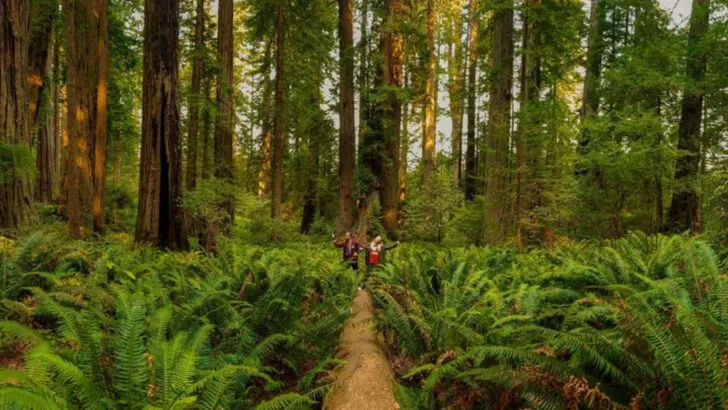Yosemite gets the fame — Calaveras Big Trees steals your heart. Tucked away in the Sierra Nevada, this under-the-radar California park delivers towering sequoias, jaw-dropping trails, and a quiet kind of beauty that hits you in the chest. Fewer crowds. More wonder. And trees that make you feel tiny in the best possible way. But it’s not just about the views. This place is laced with old Gold Rush history, rugged stories, and a wild spirit that still lingers in the air. One minute you’re standing in awe beneath ancient giants, the next you’re tracing the steps of prospectors who once chased dreams through these woods. If you’re craving Yosemite-level magic without the chaos, Calaveras is calling — and it’s long overdue for the spotlight.
Giant Sequoias That Tower Over the Trail
Standing beneath the colossal giant sequoias of Calaveras is akin to stepping back in time. These natural giants, some over 250 feet tall, have withstood the test of centuries, silently observing the world change around them. Walking among these trees evokes a profound sense of scale and history.
The forest floor is often dappled with sunlight filtering through the canopy, creating an enchanting play of light and shadow. Many of these trees boast a lifespan exceeding 1,000 years, serving as living testaments to nature’s resilience and grandeur.
Dogwood Blossoms in Spring
In the rejuvenating months of spring, the dogwood trees at Calaveras burst into a spectacular display of white blossoms. These delicate flowers contrast beautifully against the rich, dark bark of the surrounding trees, creating pockets of brightness in the forest.
The ethereal blooms seem to dance in the gentle breeze, infusing the air with a subtle sweetness that softens the rugged terrain. As sunlight filters through the branches, the blossoms appear almost luminescent—a fleeting but unforgettable sight that marks the forest’s transformation after winter.
Ferns Along the North Grove Trail
The North Grove Trail is a serene path where nature’s subtleties come alive, particularly in the form of delicate ferns. These lacy plants carpet the ground, thriving in the cool shade provided by the towering sequoias and sugar pines.
Their soft, green fronds offer a gentle contrast to the rugged, textured bark of the trees above. As you meander along the trail, the ferns’ presence creates a cooler microclimate, providing a refreshing respite on warmer days. This lush undergrowth is a testament to the biodiversity and delicate balance of the forest ecosystem.
Wild Azaleas Near Beaver Creek
Along the banks of Beaver Creek, wild azaleas offer a splash of color and a delicate fragrance to the serene landscape. These pale pink blossoms appear in early summer, drawing the attention of native pollinators and nature enthusiasts alike.
The azaleas thrive near water sources, their beauty juxtaposed against the clear, running creek. Their sweet scent fills the air, creating an unexpected delicacy amidst the towering sequoias and dense forest. This enchanting scene is a reminder of the diverse flora that flourishes in this vibrant park.
Sugar Pines with Record-Length Cones
Sugar pines, known for their remarkable height and slender trunks, often stand just outside the dense sequoia groves of Calaveras. Their cones, some exceeding a foot in length, are a notable feature and can often be found scattered along trails and picnic areas.
These trees contribute to the park’s rich tapestry of plant life, their presence a striking contrast to the massive sequoias. The cones’ distinctive size and shape are a favorite among visitors, often collected as souvenirs or admired for their natural beauty and intricate design.
Moss-Covered Logs and Tree Bases
In the shaded corners of Calaveras Big Trees, the air remains damp enough for moss to thrive, creating soft, green carpets on fallen logs and the bases of ancient trees. This lush covering signals the presence of moisture and a vibrant ecosystem.
The moss adds a layer of softness and color to the forest, a vivid contrast to the rough, brown bark of the towering sequoias. This natural phenomenon creates a sense of enchantment, as if the forest itself breathes with life, whispering secrets of its ancient past.
Western Red Cedars Along Wet Banks
In the moist and shaded areas of the park, Western red cedars thrive, their reddish bark peeling in elegant strips. These trees, with their earthy aroma, contribute to the forest’s serene ambiance, especially near the streams and wet banks.
Their needles, when crushed, release a subtle fragrance that enhances the sensory experience of the forest. The presence of these cedars adds to the diversity of the park’s landscape, offering a striking visual and olfactory element that captures the essence of this hidden California gem.
Manzanita Shrubs with Red-Barked Twists
Manzanitas line the drier slopes, with their smooth red bark and tiny pink flowers. These hardy shrubs often grow in tangled clusters and add a sculptural look to sunlit areas.
Charming Historic Towns Nearby
Just beyond the park’s borders lie towns that seem untouched by time. These charming communities offer a glimpse into the Gold Rush era, with preserved architecture and vibrant local culture. Strolling through these streets feels like stepping back in time.
The towns are alive with stories, from bustling markets to quiet cafes where you can sip coffee and watch the world go by. Each visit is a journey into the past, filled with the warmth and hospitality of its residents. It’s an enriching experience that complements the natural beauty of the park.
Incense-Cedar with Fibrous, Cinnamon Bark
Incense-cedars stand out for their vertical reddish bark and spicy scent. Their trunks often grow close together and create a quiet, wind-buffered atmosphere in parts of the forest.
Old Mining Trail
Winding through the dense forest, the old mining trail is a journey into the heart of California’s Gold Rush history. This path, once trodden by miners hopeful for riches, now offers a peek into the past with remnants of old equipment and tales of the people who once worked these lands.
The trail is more than just a walk in the woods; it’s an immersive experience where history is brought to life. Informational signs along the way provide context and stories, enriching your understanding of the challenges and triumphs faced by those who shaped this region.
As you traverse this trail, the whispers of history accompany you, turning each step into a journey through time. It’s a reminder of the determination and spirit that defined an era and continues to inspire adventurers today.
Redbuds Blooming on the Park’s Edges
In spring, redbud trees add flashes of pink to the park’s lower elevations. Their blooms come before leaves appear, making them stand out vividly along roadways and trail entrances.
Goldenrod and Wild Lupine in Open Meadows
In sunlit meadows, late spring and summer bring goldenrod and purple lupine into bloom. These flowers attract bees and butterflies and bring color to open forest glades.
Ponderosa Pines and Their Butterscotch Bark
Tall ponderosa pines often grow near campgrounds, where their bark smells faintly of vanilla or butterscotch when warmed by the sun. Campers often press their noses to the bark just to catch it.
Seasonal Snow Plants in Early Summer
After snowmelt, bright red snow plants emerge from the forest floor. These rare, rootless plants don’t use photosynthesis—they stand like coral in the dirt, growing only for a short time each year.
Ceanothus (“California Lilac”) Adding Soft Purple Tones
This native shrub blooms with light purple flowers in early summer. Though not a true lilac, its fragrance and hue make it feel like a floral accent to the rugged forest backdrop.
Bracken Ferns in Sun-Dappled Gaps
Bracken ferns, with tall triangular fronds, grow in open areas with partial shade. Their shape creates texture and movement, especially as they sway slightly in the afternoon breeze.
Fireweed on Burn Scars and Open Slopes
Where past fires have opened the canopy, fireweed is often the first to return. Its tall stalks of pink flowers show nature’s resilience and give color to places still recovering.

